NCERT Solutions for Class 5 Maths - The Fish Tale - 2
Page No. - 9
Passage: In one trip the log boat brings about 20 kg of fish. But other types of boats bring a bigger catch as given in the table.
 The table also shows the speed of each type of boat, which is how far each boat goes in one hour. Look at the table and calculate —
The table also shows the speed of each type of boat, which is how far each boat goes in one hour. Look at the table and calculate —
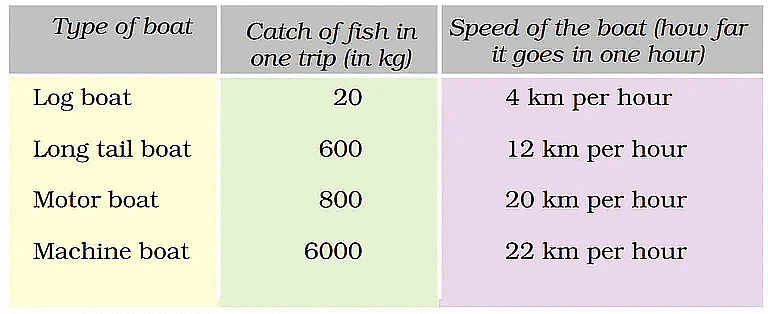
(a) About how much fish in all will each type of boat bring in seven trips?
Ans.
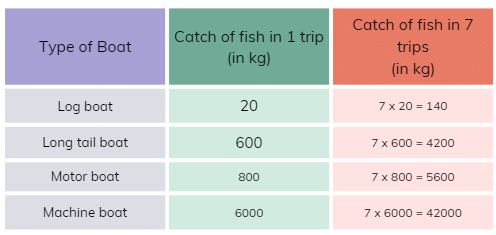
(b) About how far can a motorboat go in six hours?
Ans.
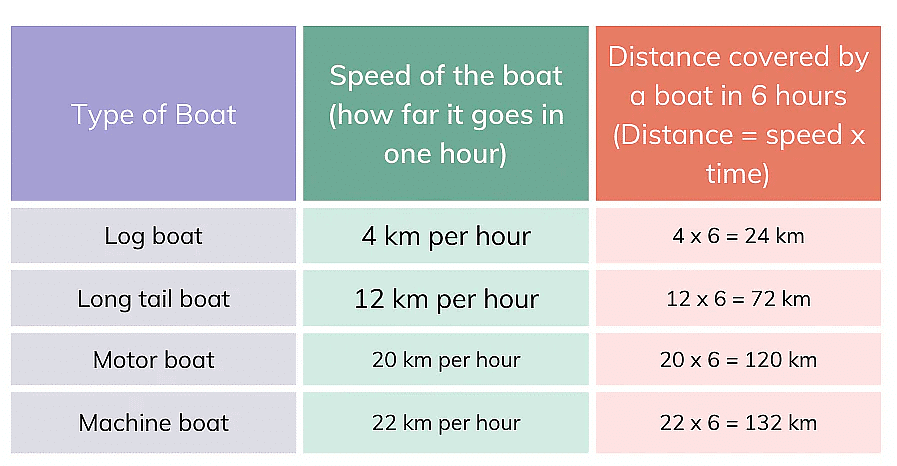
(c) If a long-tail boat has to travel 60 km, how long will it take?
Ans. From the given table, a long-tail boat travels at a speed of 12 km per hour.
So, the time taken by the long tail boat to travel 60 km
= distance/speed
= 60 /12
= 5 hours.
Page No. - 10
Passage: "In the Class IV Math-Magic you heard of the number which is equal to a hundred thousand. You had read that there are about one lakh brick kilns in our country, where bricks are made".
(a) What other things have you heard of in lakhs?
Ans.
(i) Cost of truck
(ii) Cost of bus
(iii) Population in towns, etc.
 (b) Write the number one thousand. Now write one hundred thousand. So how many zeroes are there in the number one lakh? Easy, isn’t it?
(b) Write the number one thousand. Now write one hundred thousand. So how many zeroes are there in the number one lakh? Easy, isn’t it?
Ans. One thousand = 1000
One hundred thousand is also called 1 lakh = 1, 00, 000
Then, the total number of zeros in one lakh = 5
(c) There are about two lakh boats in our country. Half of them are without a motor. What is the number of boats with a motor? Write it.
Ans. From the question, it is given that there are about two lakh boats in our country.
Then, half of them are without a motor.
The number of boats with a motor = 2,00,000/2
= 1,00,000 motors.
(d) About one-fourth of the boats with a motor are big machine boats. How many thousand machine boats are there? Come on, try to do it without writing it down.
Ans. From the question, it is given that about one-fourth of the boats with a motor a big machines.
Number of boats = 1,00,000
1/4 × 1,00,000 = 25,000
Therefore, the number of machine boats = 25,000
(e) Where have you heard of a crore? What was the number used for? Try writing the number 1 crore.
Ans. I heard of a crore in the population of a country.
1 lakh= 1,00,000
1 crore = 100 lakh
1 crore = 1,00,00,000
Total number of zeros is 7.
Page No. - 11
Q.1. At what price per kg did Fazila sell the kingfish?
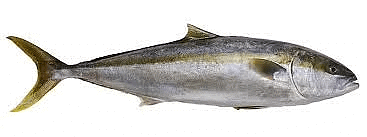 Ans. Fazila can hardly carry the big kingfish and she says this fish weighs 8 kg. So, she will sell the whole for ₹ 1200.
Ans. Fazila can hardly carry the big kingfish and she says this fish weighs 8 kg. So, she will sell the whole for ₹ 1200.
Then, the price of that kingfish for one kg = 1200/8
= ₹ 150 per kg
Q.2. Floramma has sold 10 kg of prawns today. How much money did she get for that?
 Ans. Floramma sells prawns for ₹ 150 a kg.
Ans. Floramma sells prawns for ₹ 150 a kg.
Given that Floramma has sold 10 kg of prawns today.
So, the total amount she gets = 150 × 10
= ₹ 1500
Q.3. Gracy sold 6 kg swordfish. Mini has earned as much money as Gracy. How many kg of sardines did Mini sell?
 Ans. Given that Gracy sold 6 kg of swordfish,
Ans. Given that Gracy sold 6 kg of swordfish,
Then the price of one kg of swordfish = ₹ 60
Total money earned by Gracy
= 6 × 60
= ₹ 360
Mini sold sardines at ₹ 40 per kg.
Total weight of sardines sold by Mini
= 360/40
= 9 kg.
Q.4. Basheer has Rs 100. He spends one-fourth of the money on squid and another three-fourth on prawns.
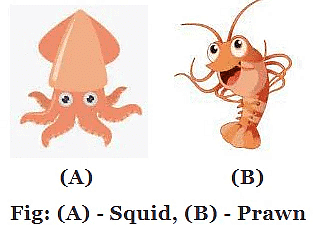
(a) How many kilograms of squid did he buy?
Ans. Given, that Basheer has ₹ 100
He spends one-fourth of the money on squid = 1/4 × 100
= ₹ 25
Krauthammer sells squid for Rs 50 a kg.
Basheer bought = 25/50 kg
= 1/2 kg of squid.
(b) How many kilograms of prawns did he buy?
Ans. Given that Basheer has ₹ 100.
He spends another three-fourths on prawns = 3/4 x 100
= ₹ 75
Floramma sells prawns for Rs 150 a kg.
Basheer bought = 75/150
= 1/2 kg of prawns.
Page No. - 12
Passage: Women’s ‘Meenkar Bank’ - The meeting of the Meenkar Bank has just begun. Fazila is the president. Twenty fisherwomen have made their bank. Each saves Rs 25 every month and puts it in the bank.
 Q.1. How much money does the group collect each month?
Q.1. How much money does the group collect each month?
Ans. There are twenty fisherwomen in the Women’s ‘Meenkar Bank’.
Each saves ₹ 25 every month
So, total money collected in the bank each month = 20 × 25
= ₹ 500
Q.2. How much money will be collected in ten years?
Ans. So, from the above solution, the total money collected in the bank per month = ₹ 500
Then, the total money collected in the bank in one year = 12 × 500
= ₹ 6000
Now, total money collected in the bank in 10 years = 6000 × 10
= ₹ 60000
PRACTICE QUESTION
Passage: Gracy needs money to buy a net. Jhansi and her sister want to buy a log boat. So they take a loan from their bank. They will return it with interest.
(a) Gracy took a loan of Rs 4000 to buy a net. She paid back Rs 345 every month for one year. How much money did she pay back to the Bank?
Ans. From the question, it is given that,
Gracy took a loan of ₹ 4000 to buy a net.
She paid back ₹ 345 every month for one year.
Then,
Total money she paid in one year to the bank = 12 × 345
= ₹ 4,140
(b) Jhansi and her sister took a loan of Rs 21,000 to buy a log boat. They paid back a total of Rs 23,520 in one year. How much did they pay back every month?
Ans. From the question, it is given that,
Jhansi and her sister took a loan of Rs 21,000 to buy a log boat.
They paid back a total of ₹ 23,520 in one year.
Then,
The total amount they pay back every month = ₹ 23,520/12
= ₹ 1,960
Page No. - 13
Passage:
"Why Don’t We Start a New Fish-drying Factory? The women of Meenkar Bank also want to start a factory to dry fish. The Panchayat has given them some land for that. Over the years they have saved Rs 74,000. They find out how much they will need for the factory".
Q.1. Fazila writes the things they need to buy to begin. See the table for the cost of each item and the number of items they want to buy. Find the total cost.
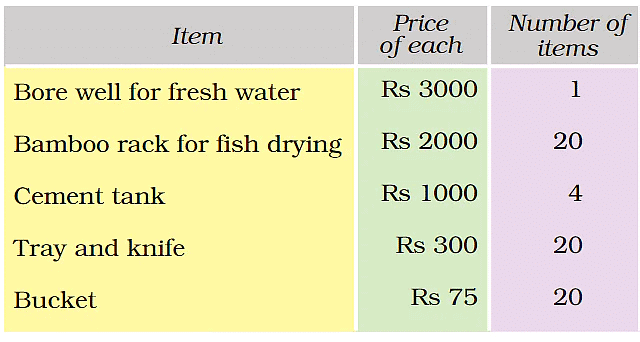
Total cost to set up the factory = ____________
When fresh fish is dried it becomes its weight. In one month they plan to dry 6000 kg of fresh fish.
How much-dried fish will they get in a month? ____________
Ans.
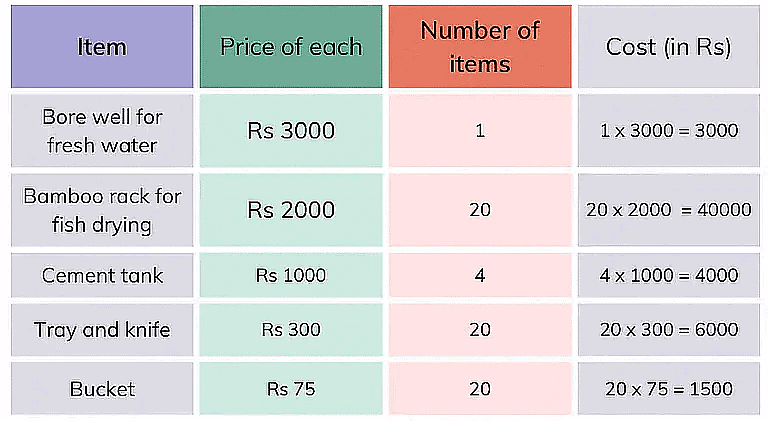
Total cost to set up the factory,
= 3000 + 40000 + 4000 + 6000 + 1500
= ₹ 54500
In one month they plan to dry 6000 kg of fresh fish = 1/3 × 6000
= 2000 kg
Q.2. Floramma – let us first calculate for 6 kg of fresh fish.
Example:
We buy fresh fish for ₹ 15 per kg.
We sell dried fish for ₹ 70 per kg.
(i) We dry 6 kg fresh fish to get _____ kg dried fish
Ans. We dry 6 kg fresh fish to get 2 kg dried fish.
(ii) For 6 kg fresh fish we have to pay 6 × __ = ₹ 90
Ans. For 6 kg fresh fish we have to pay 6 × 15 = ₹ 90
(iii) We will sell 2 kg dried fish and get 2 × __ = ₹ __
Ans. We will sell 2 kg dried fish and get 2 × 70 = ₹ 140
(iv) So if we dry 6 kg fresh fish we will earn __ – 90 = ₹ __
Ans. So if we dry 6 kg fresh fish we will earn 140 – 90 = ₹ 50
(v) But if we dry 6000 kg we can earn ₹ __ × 1000 in one month!
Ans. But if we dry 6000 kg we can earn ₹ 50 × 1000 = ₹ 50000 in one month.
Q.3. Jhansi — I found that for 6000 kg fish, we would need 1500 kg salt every month! Its price is Rs ₹ per kg.
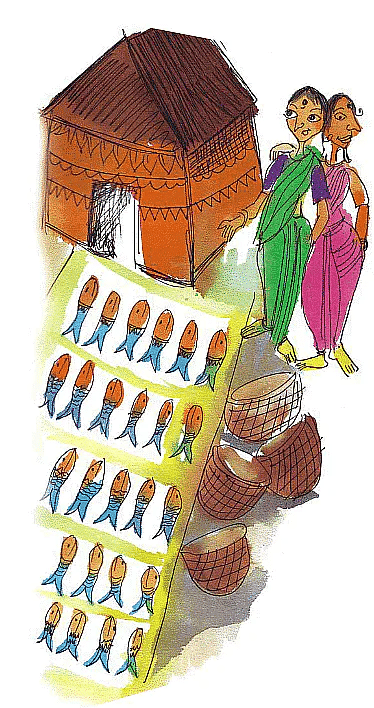 Monthly costs:
Monthly costs:
(a) Salt 1500 × 2 = ₹ ____
Ans. Salt 1500 × 2 = ₹ 3000
(b) Packing and bus charges = Rs 3000
So the total monthly cost of drying and selling the fish = ₹ ____
Fazila — That sounds very good! Our calculations tell us that every month our Bank will earn Rs 44,000!
Ans. Salt 1500 × 2 = ₹ 3000
Then, the total monthly cost of drying and selling the fish
= ₹ 3000 + 3000
= ₹ 6000
Hence, earning = 50000 – 6000
= ₹ 44000
|
31 videos|169 docs|41 tests
|
FAQs on NCERT Solutions for Class 5 Maths - The Fish Tale - 2
| 1. What is the main theme of "The Fish Tale - 2" in the NCERT Class 5 textbook? |  |
| 2. What is the significance of the title "The Fish Tale - 2"? |  |
| 3. What are the key lessons we learn from "The Fish Tale - 2" story in the NCERT Class 5 textbook? |  |
| 4. How can we apply the lessons from "The Fish Tale - 2" in our daily lives? |  |
| 5. Are there any real-life instances where the lessons from "The Fish Tale - 2" have made a positive impact? |  |























